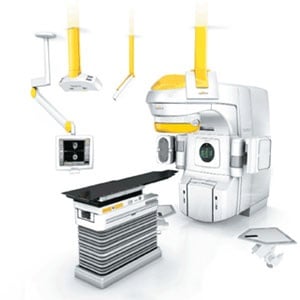
The precision of Novalis stereotactic surgery system allows neurosurgeons to deliver highly focal radiation to a cancer tumour with minimal or no damage to vital areas of the surrounding brain.
How does Novalis Radiosurgery work?
Novalis Radiosurgery consists of a high-tech radiation delivery system powered by innovative, sophisticated image-guidance and motion management tools. This state-of-the-art system rotates around you, from many different angles, delivering the cancer-fighting shaped treatment beams where they’re needed.
What types of conditions can be treated with Novalis® Radiosurgery?
Novalis Radiosurgery treats non-cancerous and cancerous conditions including:
• Acoustic neuromas
• Arteriovenous malformations (AVM)
• Brain metastases/gliomas
• Cavernous angiomas
• Craniopharyngiomas
• Intractable seizures
• Liver tumors/metastases
• Lung tumors/metastases
• Meningiomas of the skull base
• Parkinson’s disease
• Pediatric brain tumors
• Pituitary adenomas
• Prostate cancer/metastases
• Recurrent brain tumors
• Spine tumors/metastases
• Trigeminal neuralgia
Fast treatment is more comfortable and reduces the likelihood of body or tumor movements, increasing overall accuracy.
In addition to offering one of the fastest treatment times, Novalis Radiosurgery continuously tracks your body and tumor motion and automatically adjusts the beam of radiation, maintaining the highest possible level of treatment accuracy.
Read: How cancer is treated
What is the treatment advantage of Novalis Radiosurgery over other radiosurgery systems?
Other radiosurgery systems use circular beams of radiation to treat tumors and lesions. Most tumors or lesions are irregular in shape so the circular dose cannot completely conform to their exact shape.
Novalis Radiosurgery shapes the radiation beam precisely to your tumor or lesion, ensuring that the best possible treatment dose is delivered while your healthy tissue is protected.
The radiation beam also adapts to your breathing and other body movements to continuously maintain safe, complete and accurate treatment.
Undergoing treatment for a tumor or lesion can be challenging, that’s why Novalis radiosurgery is treatment designed with you in mind. Treatments are fast, lasting only minutes, and you wear a frameless custom-fit mask rather than an invasive head ring.
Read: Each cancer tumour is totally unique
Will there be any side effects?
Your doctor will discuss potential side effects with you depending on your overall treatment plan. Novalis Radiosurgery treatment is not painful in most cases and does not require anesthesia. Typically, there is no scarring or disfigurement and little risk of infection, compared to conventional surgery.
While side effects are minimized, you may experience a headache, dizziness and fatigue immediately following treatment, so driving is not recommended. Make sure to arrange for transportation home.
What affect can radiation have on my tumor or lesion?
Radiosurgery and radiotherapy use high-energy treatment beams to deliver the prescribed dose directly to your tumor cells, causing them to die. Treatment results, visible on follow-up scans, may include shrinkage of your tumor or no further tumor growth. Because cell destruction and absorption of those cells within your system can be a lengthy process, it may take up to six months before your doctor can determine the effect of treatment.
What is the difference between stereotactic radiosurgery and fractionated stereotactic radiotherapy?
Stereotactic radiosurgery and fractionated stereotactic radiotherapy refer to two treatment delivery methods. Stereotactic radiosurgery delivers a high dose of treatment to the tumor or lesion in a single session. Fractionated stereotactic radiotherapy delivers a series of treatments to the tumor or lesion over a period of time.
While both methods typically involve a similar total dose, fractionated stereotactic radiotherapy delivers treatment in smaller amounts.
Novalis Radiosurgery supports both stereotactic radiosurgery and fractionated stereotactic radiotherapy treatments. Your doctor will recommend the best treatment method for you based on your individual case.
Where can you undergo Novalis radiosurgery?
Currently at Life Vincent Pallotti Hospital in Cape Town. Life Healthcare, who imports the units, plans to invest in two more Novalis Tx units to open in Life Eugene Marais Hospital in Pretoria, Gauteng and Life Hilton Private Hospital in Kwa-Zulu Natal, later this year.
Watch the Novalis TX unit in action. Source: UCLA, Youtube
Read more:
Clive Rice's cyberknife surgery
Young brain cancer sufferer ends life with dignity
Aspirin can slow non-cancerous brain tumours
Can cellphones cause brain cancer?




 Publications
Publications
 Partners
Partners















